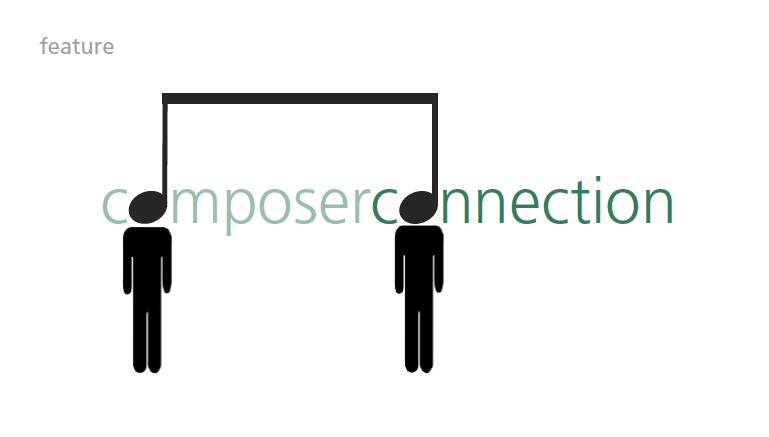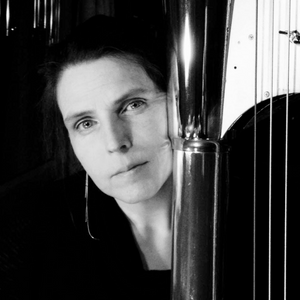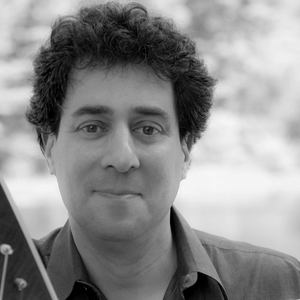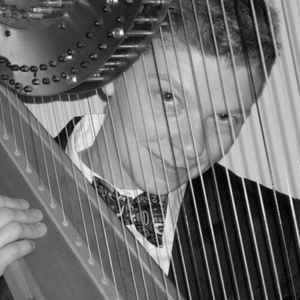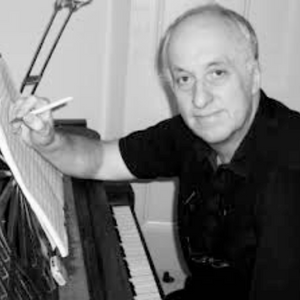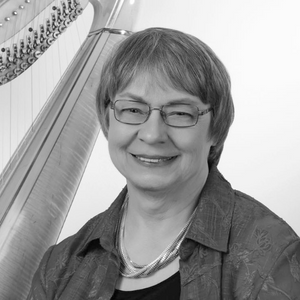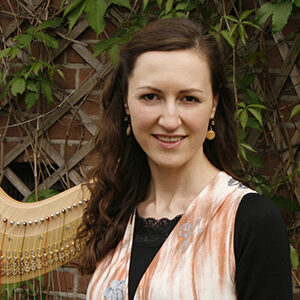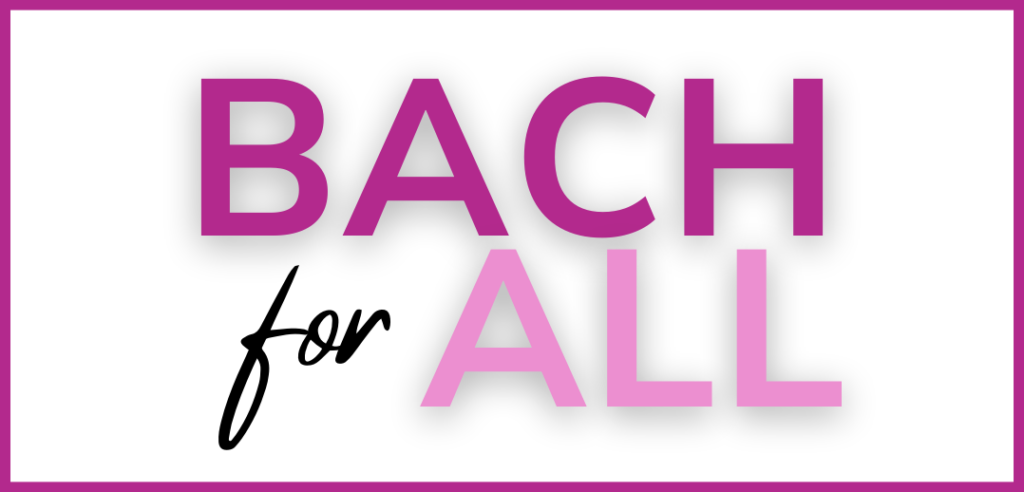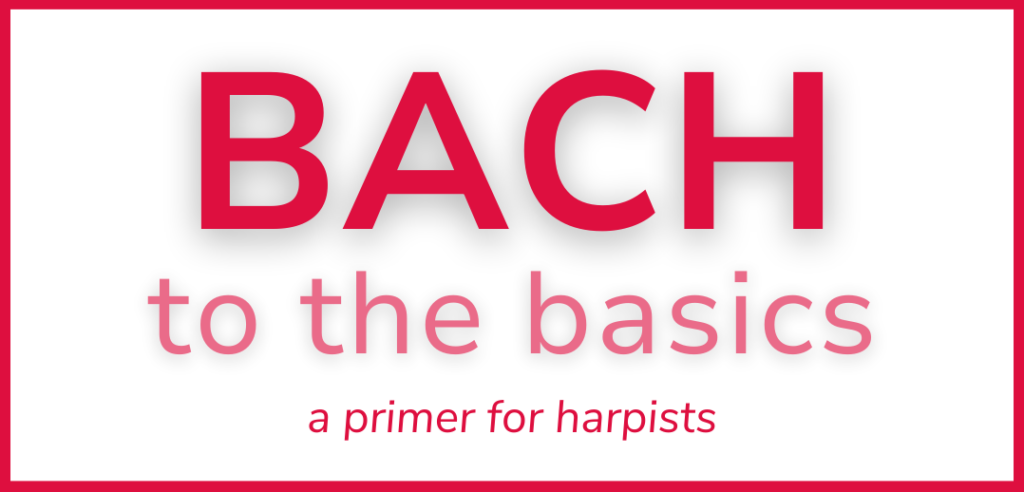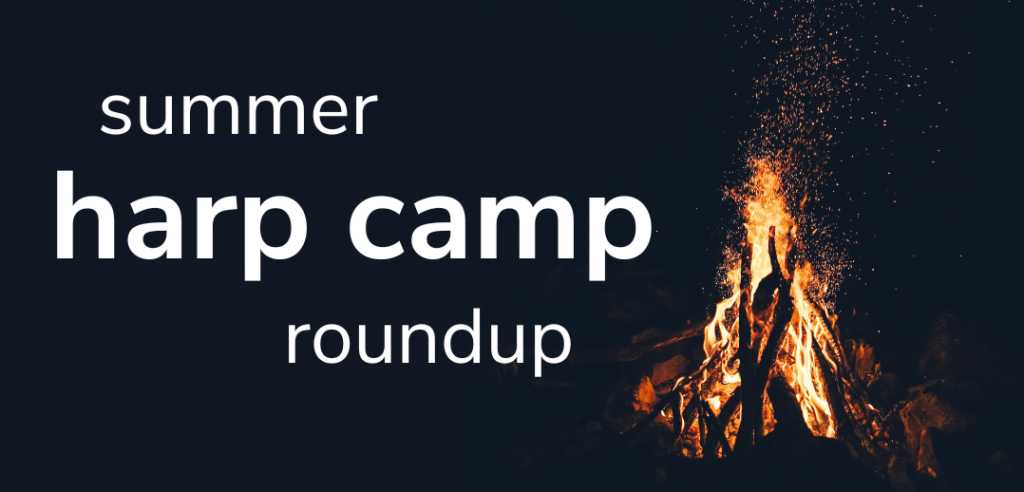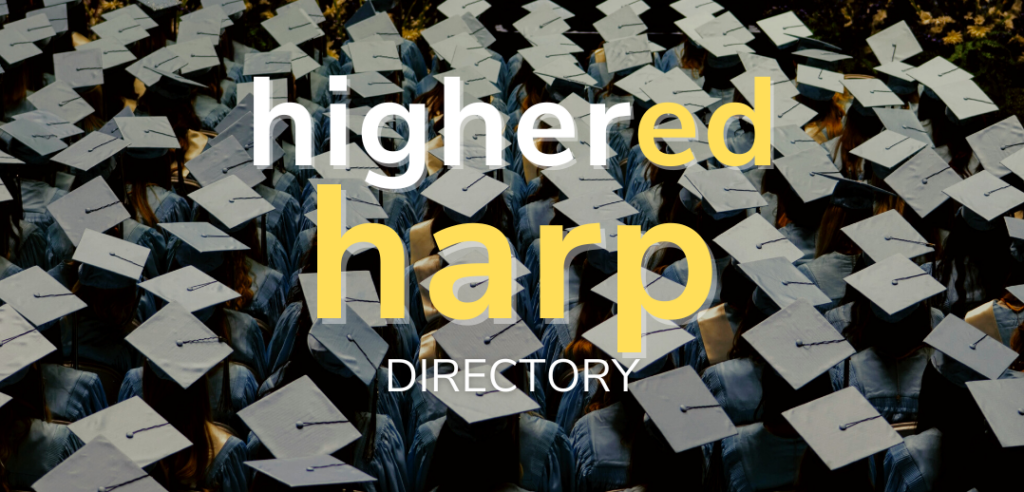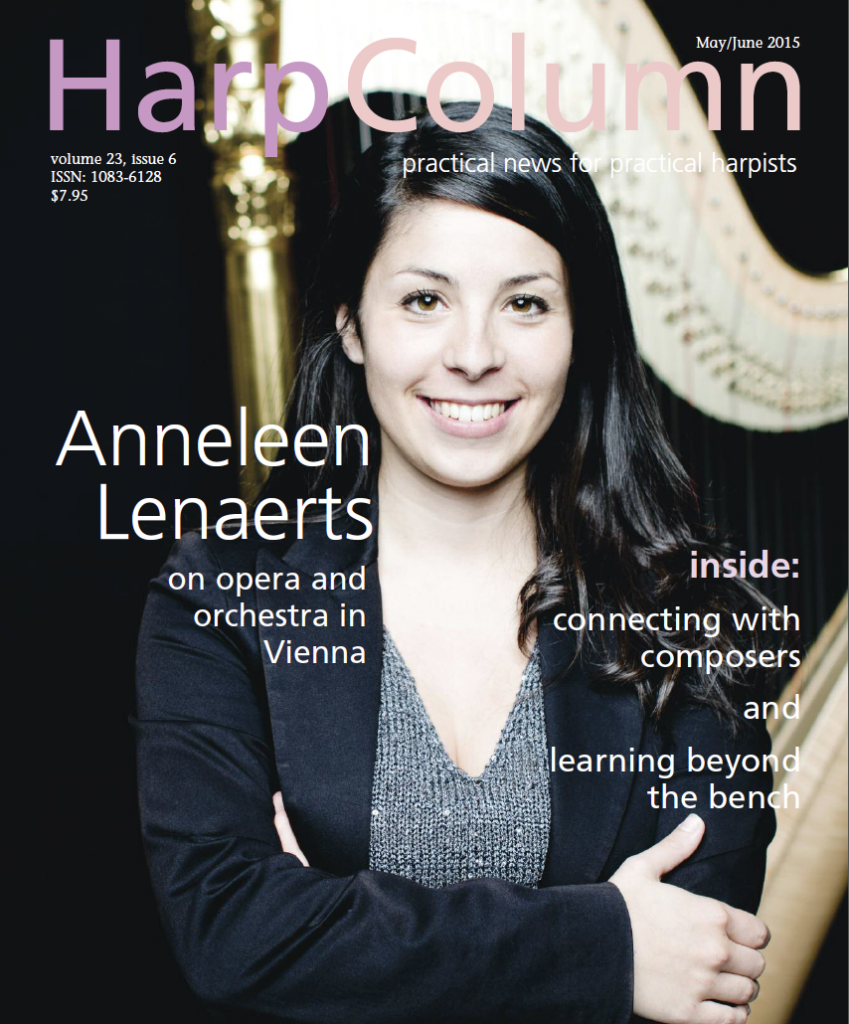Between nothing and something, between silence and sound, between a finger poised on a string and the burst of vibration at its release, lies the miracle of musical creation.
You wield this primitive magic every time you play your instrument. The fulfillment it brings is probably the underlying reason you started playing the harp in the first place. But how much of the process do you truly own? What exactly is going on in that stillness before the notes ripple through the air? If you want to know the full story behind a piece, you must turn to its composer. Unless you happen to compose your own music, the roles of composer and musician are divided between two separate people. You are not on your own; you are part of a collaboration. But you and your collaboration partner may be separated from each other by vast amounts of time and space, with nothing more connecting you than a message written in notes and markings on a sheet of music paper.
You may not be able to phone Debussy to ask him about his Trio Sonata or text Salzedo with your fingering questions, but there are plenty of living composers—both harpists and non-harpists—who are not only accessible, but eager to help strengthen that collaboration between performer and composer. To explore the composer’s point of view, we talked to some familiar composers in the harp world—David S. Lefkowitz, Robert Paterson, and Paul Patterson—as well as harpist-composers Caroline Lizotte, Stephanie Curcio, and Julia Kay Jamieson. You don’t have to be a composer yourself to make music, but when you take the time to listen to what composers have to say from the other side of the score, your partnership is strengthened, and the music that reaches your listener’s ears will be richer for it.
The people behind the names
What kind of person does it take to create music? Composers all have their own personal story of how they came to composing, but they all speak, in one way or another, of an inexplicable pull to explore in their early years.
“I was improvising right from the beginning—since I was little,” says Jamieson. “I improvised on the harp and the piano and whatever instrument I was goofing off with at the time. I’ve always been creating music.”
Lefkowitz says, “There were signs in my childhood that I was probably going to be a composer. I spent more time playing with my bassoon, making strange noises, than actually practicing my scales.”
“You receive a call,” Lizotte recollects. “When I was 12 years old, I didn’t say ‘I will be a composer!’ It was something like a need. It just happened with life. It comes from your heart.”
Some hold composing degrees from prestigious institutions—Paul Patterson from the Royal Academy of Music in London; Robert Paterson from Eastman, Indiana, and Cornell; and David Lefkowitz also from Eastman and Cornell, as well as the University of Pennsylvania—while others follow a performance track and have no formal composition training. Regardless, they can all name a mentor who lent crucial guidance to their writing in the beginning. For Lizotte, this was Pierick Houdy, and she says enthusiastically that she would still name him as her favorite composer for the harp. She soaked up his wisdom by auditing his composition classes in Quebec when she was a student.
“I was lucky,” says Jamieson. “I took composition lessons from Michael Leese when I was in high school. He was married to my harp teacher, Jocelyn Chang, so he was always around during my lessons. It was a no-brainer: there’s a composer in the house, so why don’t I take composition and theory lessons after my harp lesson and make a day of it? It really helped me to figure out how to express myself the way I wanted to. A good teacher can help you come up with ideas. Or if there’s too many ideas, having a teacher to steer you can help give you focus.”
Curcio went to college in the ’50s—a time when ideas about the role of women were more restrictive. She laments that, even though she won a prize in a NYC composition contest in high school, she wasn’t encouraged to pursue it. Years later, her son gave her the kick she needed to get back into it. “When he was 19, he said to me, ‘Mom, I’m sick of hearing you play everybody else’s music, why don’t you write your own?’ And I said, ‘I’m not a composer.’ He said, ‘Yes, you are!’ He sat me down, and we started improvising together. He said to me, ‘I wish you’d quit thinking so hard. You know everything there is about harmony and theory, but you have to just hear it.’ And that did it.”“I was lucky,” says Jamieson. “I took composition lessons from Michael Leese when I was in high school. He was married to my harp teacher, Jocelyn Chang, so he was always around during my lessons. It was a no-brainer: there’s a composer in the house, so why don’t I take composition and theory lessons after my harp lesson and make a day of it? It really helped me to figure out how to express myself the way I wanted to. A good teacher can help you come up with ideas. Or if there’s too many ideas, having a teacher to steer you can help give you focus.”
Tackling the instrument
Of course, for harpists who want to compose, their primary instrument is a natural choice. Composers who are less familiar with the harp, however, may use it occasionally in their orchestral works, but find writing for solo harp or for small ensemble with harp intimidating. “So many composers are afraid of the harp,” explains Robert Paterson. “Even teachers won’t necessarily talk to students about how to write for the harp, because they don’t even know.”
“I had so much fun working with her,” Paterson says, “After that piece, one thing led to another, and I just fell into writing other pieces for the harp. The more I wrote for the harp, the more I fell in love with the instrument.”In order to navigate the instrument’s complexity and idiosyncrasies, composers need the support of a harpist in their life. Paterson met harpist Ann Yeung while studying at Indiana University. They kept in touch, and he remembers Yeung at one point suggesting “It would be great if you wrote something for harp. I’d love to play it!” Her encouragement prompted him to write Embracing the Wind for flute, viola, and harp, which Yeung premiered.
The harp is a beautiful, but extremely tricky instrument to write for. It has unique characteristics that are not generally well understood, and composers just starting to write for the harp may accidentally end up making things awkward or unplayable. When asked what they thought was the most difficult aspect of composition for the harp, they had no trouble coming up with a list of grievances.
Paul Patterson begins his with the use of the hands. “It’s a challenge to write fast music which actually fits under the hands.”
Lizotte’s big frustrations lie with vibrations and rests. “What do we do with rests? Do we muffle?” She explains that she often gets stuck writing rests just because the notational system requires each bar to be complete and she doesn’t want to clutter her scores with endlessly tied notes, but it frustrates her that harpists misinterpret this as an instruction to muffle. “No, let it vibrate! We have an instrument that is built to ring.”Lefkowitz concurs, recognizing that big jumps across registers on the harp can be difficult. “It’s harder than on the piano; you have to be more careful. You have to give more time.”
And, of course, pedals, pedals, pedals. Paul patterson says, “When I compose, I have a piece of paper to keep track of what the pedals are whenever I do something. I have pages and pages of pedal changes so that I don’t make mistakes.”
But on the flip side of the coin, they all agree that these difficulties turn out to be hidden advantages. “One of the things I love about the harp is its limitations,” says Lefkowitz. “I love thinking about and overcoming those limitations, or being inspired by limitations. For me, the hardest things to write for are piano and orchestra, because they can do pretty much anything. I sit down with my mental orchestra, and I say, ‘Talk to me. What would you like me to write for you, today?’ And the orchestra says, ‘Oh, write anything! Anything you like! Go ahead, just write!’ The piano does the same thing. ‘Whatever you want! Just write! We’ll figure out how to play it.’ But the harp doesn’t. The harp says, ‘How about this mode? How about we try this?’”
Lizotte says, “Sometimes you have a specific idea, and just changing a pedal, just for fun, makes you think, ‘Wow! Okay! I can go there too!’ The harp suggests ideas to you.”
Robert Paterson says writing for the harp isn’t necessarily difficult, but rather about finding solutions. “You can pretty much do anything you want as long as you’re aware of how the instrument works.”
Fortunately, once they have wrapped their heads around the puzzle, they all agree that it’s worth the effort. The world of different sounds that can be made with the harp is intoxicating.
“I like that there are so many different colors and effects that you can take advantage of with the instrument,” Robert Paterson says, repeating the same sentiment that all his colleagues expressed, and then taking it further. “This may sound silly, but I like the look. I like the expressive qualities of it visually. It’s a very visual instrument. In this day and age when people are so visual, and their ears are perhaps even behind what they see—because everyone looks more than they listen, in a way—I think the harp is a great instrument to introduce people to new music. Because a lot of times, what they’re hearing definitely correlates with what they’re seeing.”
He is not the only one who mentions the visual aspect. Paul patterson feels, “The vitality and the communication, particularly in the harp, with hand and body movement is very inspiring for me when that is done well and with great enthusiasm.” His next piece, “Mosquito Massacre” for harp quartet, will feature some integration of movement and sound. “There’s going to be quite a lot of theatrical movement as all the mosquitos die and we’re only left with one harp at the end. There are going to be elements of choreography for the harpists to engage the audience, not only through their playing but through what they do visually.”
Bringing new music to life
Having the chance to work with a composer during the development phase of a new piece is a lot of fun. As the harp expert in the partnership, you have a special responsibility to make sure the piece will work technically.
Lefkowitz gives his advice about how to approach a consultation with a composer: “There is one type of harpist who, when presented with something very difficult, will say, ‘I’ll make it work.’ That’s gratifying, because the composer gets to hear what she or he has written, but it’s not educational. The composer doesn’t learn how to avoid those mistakes in the future. There’s another sort of harpist who looks at a piece of music with technical difficulties and says, ‘This is impossible.’ That’s also frustrating. A third type of collaborator will take the time to say, ‘This spot is difficult, and here’s why.’ That’s the sort of information that’s really helpful.”
For harpists, though, Lefkowitz says the priority should be to talk music with the composer. “Really, we want to have musical conversations and not harp conversations. I’m always looking for people who say, ‘What are you trying to say musically? Would you like me to play this a little more rubato? A little softer?’ That’s the sort of conversation that any composer relishes with any performer.”
Robert Paterson recommends developing a lasting relationship with a composer: “If there’s a composer you really love, you can ask them for more than one piece. You don’t have to collect them and put them on a shelf one after another. It’s nice to work with different composers for variety, but sometimes it’s nice to build up working relationships between performers and composers and become a team.”
Respect the score
At all points in the life of a piece, the task for harpists who play it is to receive and understand the composer’s vision and to communicate that vision as completely as possible to the listener. When given the chance to advise harpists on how to interpret their pieces, you may be surprised to find that most composers first point right back to the score. They are keenly aware that the score is usually their only chance at getting their idea across. “I want it to sound good without me even being there,” says Robert Paterson. “I try to notate so that if I’m not there, it will still come across, as long as you follow what’s there on the page.” Explaining her creative process, Lizotte says, “When it’s time to write the score, I disappear for months, and I go really into the score, trying to be as specific as I can so the performers will understand what I’ve been doing.” Everything they write is there for a reason, and yet details are often overlooked by the performer.
Lefkowitz says, “One common error that I found is that when I say l.v. (laisser vibrer), the harpist will say, ‘Okay, but you don’t mean that.’ Or if I say staccato.”
“Sometimes people forget to read the notes at the beginning,” says Robert Paterson. “I usually have notes at the beginning of the score, and sometimes the parts, which explain some notational devices and what they mean.”
Even the title can be an important clue for how to interpret the piece, according to Curcio. “Most of the time I name a piece with the hope of giving the player a concept of what it might sound like. Sometimes it takes me forever to find the right name for a piece. But I want that to give the player an entry to my musical thoughts. I do that with tempi also. I like to put that in there too, and most of the time that’s what they ignore.”
Tempo was mentioned again and again. Composers may be more sensitive to your choice of tempo than you think. For Paul patterson, “The oversight I think which affects me the most is when someone plays something far too slow so it becomes boring.”
Robert Paterson says it’s one of the more common issues that comes up with his music. “Sometimes harpists tend to play with tempos that are too slow or too fast. I mean, if you go two notches or so above or below, it’s probably fine, but more than that it starts to sound like the mechanics of the piece aren’t going to work. It’ll sound too lethargic or too frantic.”
Make it your own
As Paul Patterson says it so succinctly, “There’s only so much you can write in the score.” Once you have read and understood everything the composer has written, it’s time to play your part in the creative process. He says that when he coaches harpists on his music, he tells them to take what’s on the page—an accent, a phrase, a rhythm, or a glissando—and give it direction or follow it through with a dynamic, even if it may not be written.
Curcio says, “With professional performers, I like the idea of seeing how the music speaks to them. For instance I have a piece called ‘Two in Flight,’ for flute and harp. I have heard it played as a sparrow, a vulture, and a number of different kinds of birds!”
Jamieson explains that when she coaches students on her music, “I’m trying to get them to attach to it, to care about it, to think about it, and then go from there with it. Sometimes, you catch a student who plays a note, and it’s just a note. And I’m thinking, ‘Can you make it more than a note? Can you care about that one?’ I try to get them to approach their part like it’s very important and to know what they’re playing, instead of it feeling like they are reading a book out loud and not understanding what it means.”
Lefkowitz shares that one of the most rewarding aspects of composing for him is “hearing a performance in which the performer has conviction. Where they’ve found the beauty in the music, or they’ve found what the music is about, or what they believe the music is about, and have come up with an interpretation that has conviction and works.”
Get in touch
Reading the score—thoroughly studying it and making sure you’ve seen everything—is an important first step to figuring out what the composer intended. After that, you can be sure that you have the liberty to make it your own and find the meaning within the piece that most resonates with you. Ultimately, however, nothing replaces getting in direct contact with the composer.
Jamieson says, “It’s important to me that harpists know why I wrote a certain piece and what I was thinking about. I feel they should get to know me and get to know my piece, so it’s more meaningful to them.”
“If you have questions, come and talk to me—I’m here!” Lizotte implores. “It’s a good time to take advantage of that. It’s so easy today, with Skype. I have lots of consultations over Skype. We should take advantage of our era of communication to be in this intimate relation with a composer and the music.” Now that her music is being played all over the world, it is not uncommon for her to come across new recordings of her music that she didn’t know about, and if there are mistakes in a performance it gives her a pang of regret that they could have been prevented by consulting her. “Be conscious that I’m there, listening,” she reminds us.
Having that direct contact with a composer can bring a great deal of inspiration to your playing. Certainly, it is one of the most rewarding things for a composer—seeing their work brought to life. “Watching the piece be performed [is the most rewarding part of composing,]” says Jamieson. “I love watching what other people put into my music. It’s almost always a good surprise. I like how much more my piece can be when it has the added bonus of going through someone else’s brain. It’s rewarding to see it come to life that way, and to see it grab someone or make someone smile.”
Curcio also loves hearing from harpists who play her music. “I get an awful lot of emails and notes, especially from teachers saying how much they enjoy, and how much the students enjoy, learning through this music.”
“It’s lonely being a composer, alone at home writing a piece,” adds Paul patterson. “You deliver the piece to the harpist on paper, and it’s then their job to communicate and pass on all those things to the audience. The collaboration between the music and the performer to the audience is a rather special one and very important to me.”
If there’s one thing to take away from this discussion, it should be the inspiration to connect with a composer. As these six composers make clear, not all composers are distant, unreachable gods like Debussy and Bach. There are many that are very much alive today and open to making new connections. It doesn’t just help you; consulting with a harpist may be the critical step a composer needs to start feeling comfortable writing for the instrument. So go inspire some new music! Your friendship with a composer could be the seed that grows into a new piece. Or maybe it’s time for you to indulge that interest in composing you’ve always had. Who knows? You may have the composing bug hiding somewhere inside you too. •
Expert Advice
Ever thought about writing an original work for the harp? Here are some tips from the experts:
Do it! For me, the hardest part is just sitting down and doing it. You have to be fearless and just try things out. It’s okay if what you come up with is bad and you have to go fix it or you have to try again. By listening and being curious, you can gather ideas and learn more about composing. Take lessons too. Teachers have good ideas.
Julia Kay Jamieson
I’ve worked with several students who were natural composers and enjoyed creating music, but who, in the course of their professional music studies, were not supported or were even outright discouraged from developing their abilities. We need to encourage our students to improvise! Encourage their creativity, and let them be free enough to find their own voice.
Stephanie Curcio
I always say, I think every composer should perform, and vice versa, every performer should try composing. If you’re a young harpist and you’re in school, if there’s a way you can take composition lessons, even from a graduate student—it doesn’t even have to be one of the main professors—you might learn a lot that will help you understand the art of composing and that will help you write better music. If you really want to write stuff that’s timeless, that’s compelling for lots of people, it’s good to have some training. Get people who have experience to work with you and make sure your music is compelling.
Robert Paterson
Having been myself supported by Kathleen Bride while I was studying with her at Eastman, also by Catherine Michel, who encouraged me to pursue the tradition of harp music written by a harpist/composer, I would say to harpists who have this call inside themselves: If you have something to say, push your capabilities—go for it!
Caroline Lizotte
Let your fingers and feet guide you, but only for a very short amount of time. Use them to present sounds—melodies, harmonies, timbres—as objects that you can work with. But then once you do that, you have to move away from the harp and not touch it again until you’re done with the piece of music, unless you want to check what feels better: this or this. The composition has to be structured as a composition. Get inspired by your own ability with the harp, but then create a piece of music that works in more-or-less established forms and let that carry you forward as a composer.
David S. Lefkowitz
Do not get so involved exploring special techniques that you forget to give the music direction. Another thing is to have some strong musical material which can be explored and extended. That is one of the real challenges of composition. It’s all about taking an idea and developing it, rather than having lots of different ideas following each other.
Paul Patterson





